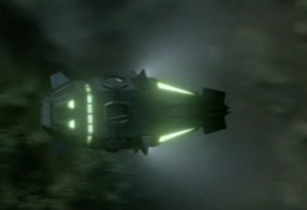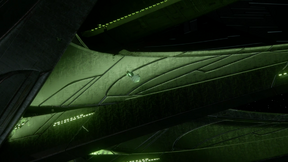
An escape pod was a type of pod, a small vessel, used by larger spacecraft for evacuation. Typically, escape pods were used as a last resort in the face of the host ship's imminent destruction. Escape pods were used by a variety of space-flight capable civilizations, such as the Planetary Union and the Krill.
Planetary Union
Union ships carried a host of escape pods, including the USS Orville. In the event of an emergency, a ship's Computer guided each crew member to the nearest escape pod. If the Computer was down, crew members were expected to gather at their assigned muster station. Senior level officers then organized evacuation.[1]
Escape pods were located at dedicated ports throughout the ship. In the event of an emergency, escape pods were automatically routed through the lift as well.[1] An emergency beacon was automatically activated upon deployment, with a signal range of 100 light years. Once in flight, pods could interlink with each other or dock at a port. The escape pod had a travel range of up to 10 billion kilometers.[2] An escape pod could maintain a safe environment with a steady supply of food for at least three months.[2] An escape pod could also be joined by a cargo pod, which carried additional supplies and emergency equipment for the crew upon landing.
Each escape pod carried two PM-44s,[1] a Food Synthesizer,[2] a utility knife with a self-sharpening nanoceramic blade, an ultrathermic torch, macromolecular carbon polyfabric, ionic water sterilization cartridge, atmospheric water vapor condensor, concentrated nutrition wafers, polymetric multitool, two class seven luminators, and playing cards. The pod also had a medical kit, containing essential equipment for a Medical officer.[1]
Scanner arrays informed the pod's computer about a potential landing site's atmospheric and biological conditions, including searching for harmful pathogents.[3] All escape pods were powered by dysonium, though most of its energy went to maintaining a stable environment and its food synthesizer. Air and water were continuously recycled. There were multiple kinds of escape pods. Exploratory-class vessels such as the Orville carried two types: 120 two-person escape pods and 20 four-person escape pods.[2]
An escape pod was designed for a single flight. Once landed, the pod could not return to space.[2] The pod was designed to work in temperatures as low as near-absolute zero. If the pod landed in water, a flotation ring would immediately deploy and the pod's maneuvering thrusters would help the officers move through the water a bit.[4]
Krill

Krill escape pods were found on Krill destroyers located along the exterior hull of the ship. They were not found in the Shuttle Bay.[5]
Escape pods were designed with the unique needs of Krill physiology in mind; they aimed towards the closest habitable world and by default sought the planet's night side to protect the Krill passenger from a star's deadly ultraviolet radiation.[5]
Escape pods were accessible by special doorway that could be opened manually in the event the destroyer lost even its backup emergency power.[5]
Each escape pod came equipped with a portable distress beacon.[5]
History
When the Chak'tal attack a Krill destroyer in late 2420, Teleya and Captain Ed Mercer fled by escape pod to the nearest habitable planet.[5]
After the Orville incurred heavy damage in the Battle of Earth in early 2421, Ed ordered all hands to escape pods, as he intended to overload the quantum drive.[6] In an alternate timeline, the crew of the Orville fled the Battle of Earth by escape pod.[7]
Production
Krill escape pods were designed by assistant art director Kit Stølen. In the first concept designs, the pod was boxy, like a tapered decagonal prism. The concept art was forwarded to set designer Daniel Saks, "who refined and remodeled it in a vector based CAD, in order to prep the design for large 3D Printing."[8] Final architectural blueprints for set construction were drafted by Eugene Adamov.[9]
The final product was more-or-less the same as Stølen's designs, although Saks apparently widened the pod to make it more more ovoid and egg-shaped.
Appearances
- Episode 2x04: Nothing Left on Earth Excepting Fishes
- Episode 2x09: Identity, Pt. 2 (mentioned only)
- Episode 2x14: The Road Not Taken (mentioned only)
- Episode 3x01: Electric Sheep
References
- ↑ 1.0 1.1 1.2 1.3 André Bormanis. The Guide to The Orville. Dark Horse Books. Sept. 2024. Pg. 48.
- ↑ 2.0 2.1 2.2 2.3 2.4 André Bormanis. The Guide to The Orville. Dark Horse Books. Sept. 2024. Pg. 49.
- ↑ André Bormanis. The Guide to The Orville. Dark Horse Books. Sept. 2024. Pg. 46.
- ↑ André Bormanis. The Guide to The Orville. Dark Horse Books. Sept. 2024. Pg. 55.
- ↑ 5.0 5.1 5.2 5.3 5.4 Episode 2x04: Nothing Left on Earth Excepting Fishes
- ↑ Episode 2x09: Identity, Pt. 2
- ↑ Episode 2x14: The Road Not Taken
- ↑ @KITST7LEN. "Early concept I did for the Krill Escape pod Exterior. It would then go onto Set Designer @DAS_Machina who refined and remodeled it in a vector based CAD, in order to prep the design for large 3D Printing.". Twitter. March 30, 2020.
- ↑ THE ORVILLE_SEASON2. eugeneadamov.com. Last accessed March 9, 2022.